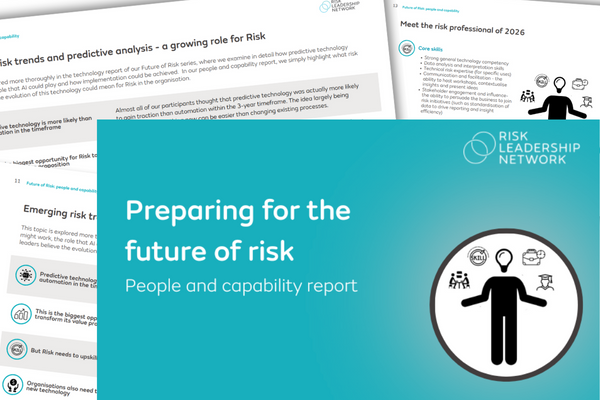How are risk leaders preparing their teams for the future?
Mature CROs are focusing on the future of the risk profession and how they can evolve their risk management approach to add long-term value to the business. So, how are they preparing their teams for this evolution, and what challenges must they overcome to keep pace with future developments?

1. Integrating automation into risk team operations
Risk leaders are somewhat divided as to how far the automation of risk-related tasks could extend in the next three years. But there is a consensus that at least a small portion of risk operations will be impacted by automation.
|
Three major conclusions from risk leaders considering automation:
|
Read more on automation in our Future of risk: people and capability report.
2. Assessing risks using predictive analytics
As the automation of risk-related tasks ramps up in the next three years, one technology that is particularly exciting for risk leaders and their organisations is predictive analytics.
Four key outcomes CROs identified for rolling out predictive analytics:
Predictive technology more likely than complete automation in the next three years
While the introduction of automation will require existing processes to change and cause disruption to the business, augmenting processes with predictive technologies may be beneficial and easier to implement in the near future.
An opportunity for Risk to transform its value proposition
The growing prominence of risk appetite and key risk indicators is laying a foundation for big-picture risk thinking, focusing as much of the business' attention on opportunities as threats. New technologies, like predictive analytics, will amplify the ability of Risk to deliver insights to the business that facilitate more strategic, future-minded conversations about what risks the organisations should, and shouldn't take.
Investment in new technology is crucial
While predictive technologies present a number of opportunities, risk leaders agree that few, if any, existing GRC systems offer this functionality. For the vision to become a reality, organisations must commit and invest. Given that there aren't many successful applications readily available, there may be an opportunity for some companies to lead the way and seize an early mover advantage.
Risk must upskill to thrive
Taking advantage of the opportunities presented by new technologies will require the risk team to develop the capabilities of existing resources or recruit new resources that can offer those capabilities. A key skill for the future, particularly in the context of leveraging predictive technologies, is the ability to interpret data in order to generate insights, create narratives and facilitate meaningful conversations about new strategies and initiatives.
What skills will the risk professional of 2026 need? Take a look here.
Where does the insight come from?A number of mature risk leaders in our network raised "preparing for the future of the risk profession" as a key priority. Through interviews with the most forward-thinking risk practitioners in the world, we're producing a series of reports examining the future of the risk profession on 6 key pillars: People, Structure, Governance, Regulation, Technology and Culture. Preparing for the Future of Risk: People and Capability was the first report in this series. After publishing the report, we facilitated a bespoke member meeting for CROs and heads of risk to discuss nuances in the report, and share their action plans for the future. To find out more about this report, request a meeting to discuss the findings and get involved in the next collaborations in the series, fill in your details here. |
3. Evolving risk training to meet business needs
Risk leaders have observed a gap between the skills risk leaders are currently seeking and the training and capability uplift programmes that are currently being delivered. So, how can this space be filled?
Specific training for cyber and AI
Not only do members of the risk team need to understand the role of Risk in the context of AI and other technologies, but they also need to build subject matter knowledge to better understand the complex nature of the risks that could impact the business.
Engagement and communication
These softer skills continue to be a major challenge for risk teams. While written and oral communication skills appear to be highly valued by organisations, it is rare for specific training in these areas to be offered to risk teams.
By cultivating these capabilities among risk professionals, the risk team will be better equipped to present to the business, explain important risk concepts and support better risk management across the organisation.
What next?
The long and the short of it - there is no single answer for 'the future of risk'. As one interviewee noted in our research, the same solution rolled out in five different places will produce five different results.
Accessing the thinking of a high quality, highly credible group of senior risk leaders is a good start - and the full analysis is available in our Preparing for the future of risk: people and capability report. Although this report is for members only, we'd be happy to meet with prospective members and discuss the key findings through a short presentation. We can also discuss how to involve you in future collaborations on the future of risk series. Request this meeting here.
Moving forwards, you'll need to identify the insights that resonate for you and your business, and develop an action plan to prepare your risk team for the future.
We'll continue to support our members with their action plans by facilitating targeted collaborations and bespoke resources (e.g. Future of Risk decision making matrices and timelines). To get involved, please book an introductory call.
Share this
Related posts you may be interested in

How to drive greater risk awareness by strengthening partnerships with Strategy

Three ways your peers are developing their risk function in light of emerging risks

